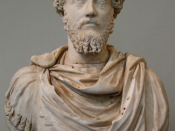Around 310 BC, Zeno of Citium founded the Stoic school, which would go on to be one of the most influential schools of philosophy in the Roman Empire during the period preceding the rise of Christianity. The school attracted many followers and flourished for centuries in Greece and Rome, where the most famous Stoics, Marcus Aurelius, Seneca, and Epictetus, followed the Stoic philosophy. The Stoic doctrine is divided into three parts: logic, physics, and ethics.
Stoic logic is basically Aristotelian logic, with one interesting addition. Stoics believed that the all knowledge enters the mind through the senses. The mind was a blank slate upon which impressions are inscribed. This is in direct opposition to Plato's belief that the mind was the source of all knowledge and that the senses fostered illusions. Yet the Stoics were not as metaphysical as previous philosophers. They denied the metaphysical reality of concepts, and instead held that the criterion of truth lies in sensation.
The truth was achieved not through thought, but through feeling.
The fundamental proposition of Stoic physics is that "nothing incorporeal exists." They were highly materialistic, as is evident by their sensation-based doctrine of knowledge. The stoics, who placed knowledge in physical sensation, believed reality was matter. They did not agree with Plato's concept that the reality had some ideal form. All things, even the soul and God, are material. The Stoic philosophy of monism demands that all things come from one principle. Body and soul, mind and thought, must be made from the same substance, which is material in nature. The Stoics, like Hericlitus, believed this substance, from which all is created, is fire. The primal fire is God, who is the "Divine Fire" that exists in everything. The human soul is likewise fire, and penetrates the entire body. While...


